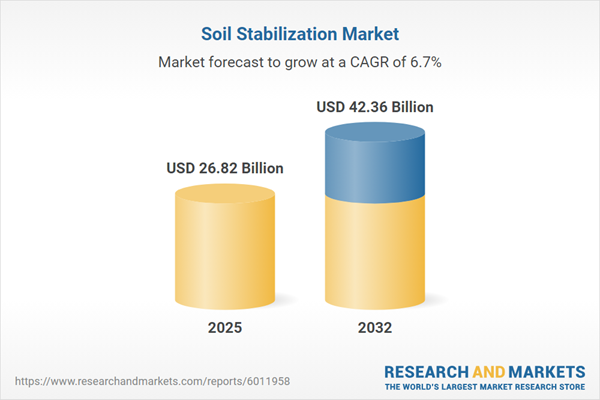Speak directly to the analyst to clarify any post sales queries you may have.
The soil stabilization market is rapidly evolving as infrastructure stakeholders embrace advanced technologies and sustainable practices to meet global construction challenges. Senior decision-makers require comprehensive, actionable insights to successfully navigate this complex and dynamic sector.
Market Snapshot: Robust Growth Driven by Innovation and Sustainability
The soil stabilization market grew from USD 25.15 billion in 2024 to USD 26.82 billion in 2025. It is projected to maintain strong momentum, with a CAGR of 6.73% through 2032, ultimately reaching USD 42.36 billion. This sustained expansion is underpinned by the urgent need for resilient foundations, evolving regulatory requirements, and innovations in materials and technology. Organizations across public and private sectors are increasingly investing in advanced stabilization to address the mounting pressures of rapid urbanization and shifting climate conditions.
Scope & Segmentation: Comprehensive Analysis Across Segments and Regions
This report provides a detailed breakdown of the soil stabilization market across product types, technology approaches, applications, end-use sectors, and geographic regions.
- Product Types: Bitumen, Cement, Fly Ash, Lime, Polymer
- Technology Approaches: Biological, Chemical, Mechanical, Thermal
- Applications: Embankments (Bridge Abutments, Highway Embankments), Foundations (Deep Foundations, Shallow Foundations), Landfill Liners (Hazardous Waste, Industrial Waste, Municipal Solid Waste), Road Construction (Airport Runways, Highways, Local Roads), Slope Stabilization (Cut Slopes, Fill Slopes)
- End-Use Sectors: Commercial (Hospitality, Offices, Retail), Industrial, Infrastructure (Airports, Highways, Ports, Railways), Residential
- Geographic Regions: Americas (United States, Canada, Mexico, Brazil, Argentina, Chile, Colombia, Peru), Europe, Middle East & Africa (United Kingdom, Germany, France, Russia, Italy, Spain, Netherlands, Sweden, Poland, Switzerland, United Arab Emirates, Saudi Arabia, Qatar, Turkey, Israel, South Africa, Nigeria, Egypt, Kenya), Asia-Pacific (China, India, Japan, Australia, South Korea, Indonesia, Thailand, Malaysia, Singapore, Taiwan)
- Key Companies: Sika AG, BASF SE, The Dow Chemical Company, GCP Applied Technologies Inc., CEMEX S.A.B. de C.V., Holcim Ltd, Heidelberg Materials AG, Anchor Systems International, Martin Marietta Materials, U.S. Silica Holdings
Key Takeaways for Senior Decision-Makers
- Deployment of advanced stabilization technologies is transforming geotechnical risk management and enhancing project durability for diverse infrastructure demands.
- Innovation in eco-friendly binders and biological amendments is reducing environmental impact, aligning project delivery with tightening sustainability standards.
- Shift toward digital tools—such as remote sensing and IoT-enabled site assessments—is driving efficiency and predictability in site preparation processes.
- Material selection flexibility is supporting adaptation to local resource availability, which is especially valuable in regions facing supply chain disruptions or regulatory change.
- Collaboration between manufacturers, engineering firms, and research organizations is accelerating product development and fostering adoption of next-generation stabilization techniques.
Tariff Impact: Navigating US Trade Measures and Market Response
The introduction of United States tariffs on key soil stabilization materials, including cement and polymers, has compelled suppliers and contractors to reevaluate their procurement models. These measures have increased costs for imported agents, prompting shifts toward locally sourced or recycled alternatives. Stakeholders are adapting by building new regional partnerships and diversifying supply channels to maintain competitiveness and minimize project delays. Rigorous quality assurance is necessary as the market adjusts to changing material sources and evolving regulatory frameworks.
Methodology & Data Sources
Our research integrates structured interviews with industry experts, targeted end-user surveys, and in-depth analysis of published industry standards, technical guidelines, and peer-reviewed journals. We validate findings through expert panel reviews and apply data triangulation techniques for integrity and relevance.
Why This Report Matters
- Strategic insight into segment growth, emerging technologies, and regulatory trends equips executives to make informed capital allocation and procurement decisions.
- Coverage of supply chain risks and regional variations supports proactive planning for project delivery, compliance, and sustainability outcomes.
- Benchmarking leading market participants provides reference points for competitive strategy and partnership development.
Conclusion
This soil stabilization market report delivers robust intelligence to guide strategy in a rapidly evolving sector. Decision-makers will gain the clarity necessary to lead through technological, regulatory, and supply chain shifts with confidence.
Additional Product Information:
- Purchase of this report includes 1 year online access with quarterly updates.
- This report can be updated on request. Please contact our Customer Experience team using the Ask a Question widget on our website.
Table of Contents
3. Executive Summary
4. Market Overview
7. Cumulative Impact of Artificial Intelligence 2025
Companies Mentioned
The companies profiled in this Soil Stabilization market report include:- Sika AG
- BASF SE
- The Dow Chemical Company
- GCP Applied Technologies Inc.
- CEMEX S.A.B. de C.V.
- Holcim Ltd
- Heidelberg Materials AG
- Anchor Systems International
- Martin Marietta Materials, Inc.
- U.S. Silica Holdings, Inc.
Table Information
| Report Attribute | Details |
|---|---|
| No. of Pages | 190 |
| Published | October 2025 |
| Forecast Period | 2025 - 2032 |
| Estimated Market Value ( USD | $ 26.82 Billion |
| Forecasted Market Value ( USD | $ 42.36 Billion |
| Compound Annual Growth Rate | 6.7% |
| Regions Covered | Global |
| No. of Companies Mentioned | 11 |









